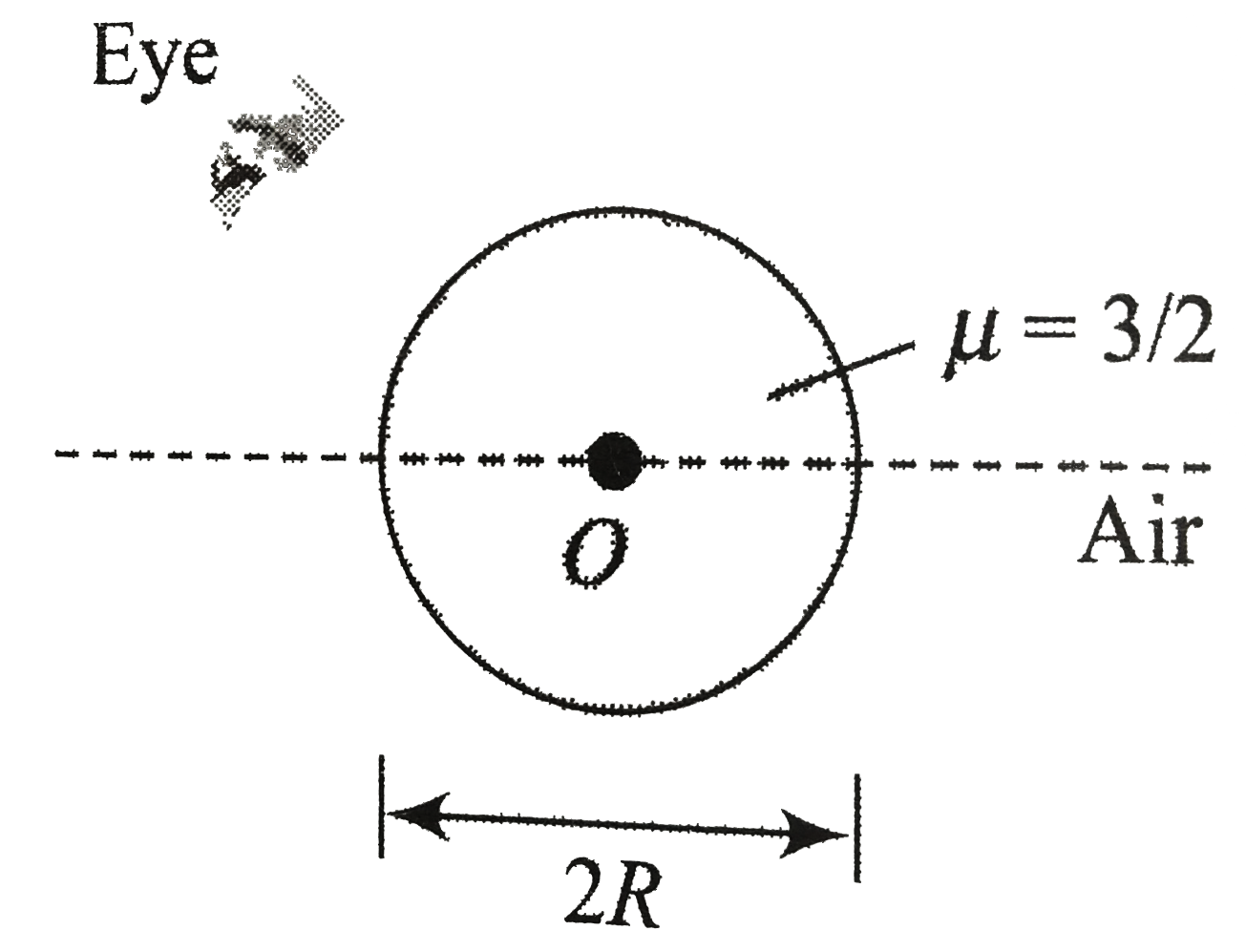Identify the statements are True of False.
a. The equation μ2v−μ1u=μ12−μ1R is applicabel to a plane surface for R=∞ .
h. In the above equation, μ1 is medium in which the object is placed and μ2 is the medium in which the image is formed.
c. In the figure shown, the real image of object O is formed at a distance 5R in the medium.

d. In figure, the image of an object O place on the center face of the sphere is formed at infinity,.

e. In fig , the image of an object O placed on the opposite face of the sphere is foremd at infinity.

a. True. For plane surfaces, μ2v=μ1u
b. False. In the equation,
μ2v−μ1u=μ2−μ1R
μ1 is the medium which comes before the boundary and μ2 is the medium which comes after the boundary.
c. True. μ2v−μ1u=μ2−μ1R
Here, μ2=1.5,μ1=1,u=5R,R=+R
1.5v−1−5R=1.5−1+R
1.5v=12R−15R=310R
v=5R
d. False. All the rays coming out from the object are radial. The radial rays are not devited with the change in medium.
e. True. μ2v−μ1u=μ2−μ1R
Here, μ2=1,μ1=2,R=−R
u=−2R
1v−2−2R=1−2−R=1R
or 1v=1R−1R<br>rArr v=oo

Topper's Solved these Questions
- GEOMETRICAL OPTICSBOOK - CENGAGE PHYSICS ENGLISHCHAPTER - GEOMETRICAL OPTICSEXERCISE - Exercise1.6
15 Videos
- GEOMETRICAL OPTICSBOOK - CENGAGE PHYSICS ENGLISHCHAPTER - GEOMETRICAL OPTICSEXERCISE - Exercise1.7
21 Videos
- GEOMETRICAL OPTICSBOOK - CENGAGE PHYSICS ENGLISHCHAPTER - GEOMETRICAL OPTICSEXERCISE - Exercise1.4
12 Videos
- ELECTRON,PHONTS,PHOTOELECTRIC EFFECT & X-RAYSBOOK - CENGAGE PHYSICS ENGLISHCHAPTER - ELECTRON,PHONTS,PHOTOELECTRIC EFFECT & X-RAYSEXERCISE - dpp 3.3
15 Videos
- HEATING EFFECT OF CURRENTBOOK - CENGAGE PHYSICS ENGLISHCHAPTER - HEATING EFFECT OF CURRENTEXERCISE - Thermal Power in Resistance Connected in Circuit
27 Videos
Similar Questions
Find the distance of object placed in the slab of refractive index μ from point P of the curved surface of radius R so that image is formed at infinity:

View SolutionA point object is placed at 30 cm from a convex glass lens (μg=32) of focal length 20 cm. The final image of object will be formed at infinity if
View SolutionThe figure ,shows a transparent sphere of radiusRand refractive indexμ.An object Ois placed at a distance x from the pole of the first surface so that a real image is formed at the pole of the exactly opposite surface.
 if an object is Placed at a distanceR from the pole of first surface ,then the real image is formed at a distance Rfrom thepole of the second surface.The refractive indexμ of the spher is given by
if an object is Placed at a distanceR from the pole of first surface ,then the real image is formed at a distance Rfrom thepole of the second surface.The refractive indexμ of the spher is given by
View SolutionA spherical surface of radius R ssparates two media of refractive indices μ1 and μ1 as shown in figure., Where should an object be placed in medium 1 so that a real image is formed in medium 2 at the same distance?

View SolutionA sphere of radius R made of material of refractive index μ2 is placed in a medium of refractive index μ1. Where would an object be placed so that a real image is formed at equidistant fromk the sphere? ltbgt

View SolutionThe figure ,shows a transparent sphere of radiusRand refractive indexμ.An object Ois placed at a distance x from the pole of the first surface so that a real image is formed at the pole of the exactly opposite surface.

If x=2R,then the value of μis
View SolutionThe figure ,shows a transparent sphere of radiusRand refractive indexμ.An object Ois placed at a distance x from the pole of the first surface so that a real image is formed at the pole of the exactly opposite surface.
 If x=∞,then the value of μ is
If x=∞,then the value of μ is
View SolutionAn object O is placed at a height h = 12 cm above water (μ=43) surface in a beaker . The lower surface of the beaker is polished , as shown in the figure . The location of final image will be

View SolutionA curved surface of radius R separates two medium of refractive indices μ1andμ2 as shown in figures A and B .
_E01_077_Q01.png)
Choose the correct statement(s) related to the real image formed by the object O placed at a distance x, as shown in figure A.
View SolutionA curved surface of radius R separates two medium of refractive indices μ1andμ2 as shown in figures A and B .
_E01_078_Q01.png)
Choose the correct statement(s) related to the virtual image formed by object O placed at a distance x, as shown in figure
View Solution
